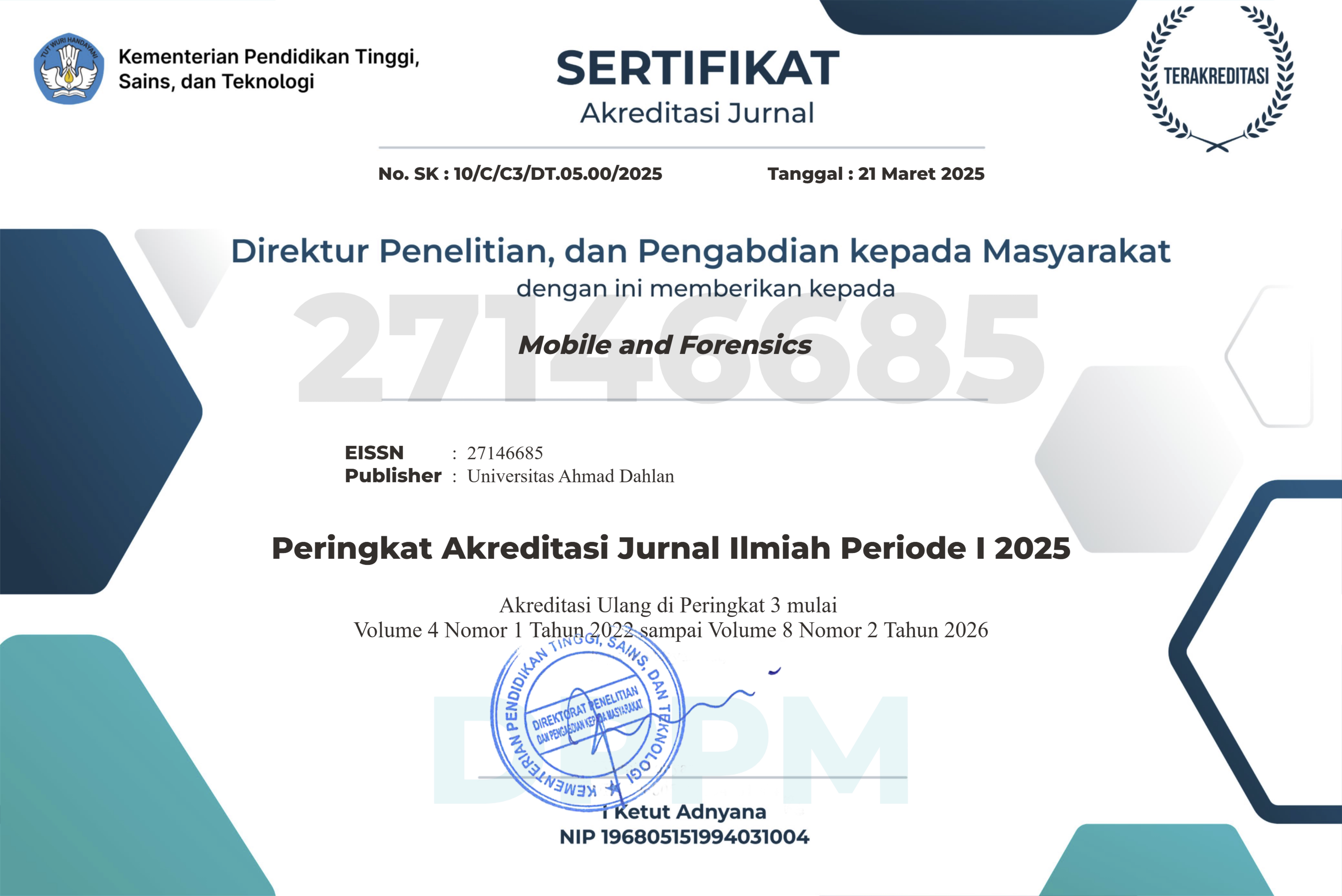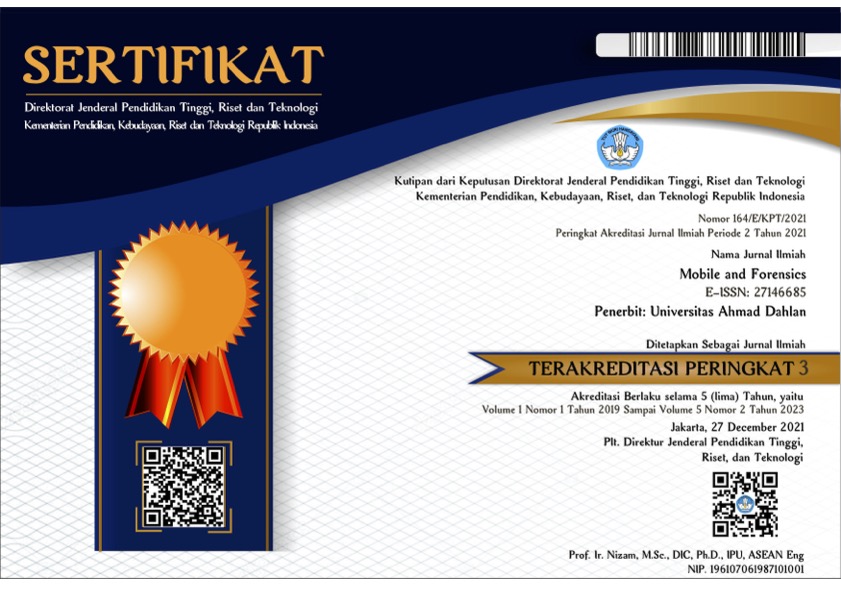National Institute of Standard Technology Approach for Steganography Detection on WhatsApp Audio Files
DOI:
https://doi.org/10.12928/mf.v6i2.11287Keywords:
Audio Files, WhatsApp, Steganography, NITS, Mobile ForensicsAbstract
Audio steganography in instant messaging applications such as WhatsApp poses new challenges in the field of digital security, especially due to the ability to hide data in frequently used formats. This research examines the effectiveness of steganography detection on WhatsApp audio files by applying a method developed by the National Institute of Standards and Technology (NIST). This approach was chosen due to its reputation in security testing standards, but its use in the context of audio steganography on instant messaging platforms has not been widely explored. The novelty of this research lies in the adaptation of the NIST method specifically for audio steganography analysis in WhatsApp, which includes testing against various compression and end-to-end encryption scenarios. The main findings of this research show that the NIST method successfully improves the accuracy of hidden message detection compared to conventional steganalysis techniques, especially under the condition of compressed audio files. In addition, this research also found that the integration of the NIST method enables more effective detection of steganographic data in encrypted audio files. These results confirm that the NIST method can be successfully adapted for instant messaging applications such as WhatsApp, making a significant contribution in the improvement of digital security. This research not only identifies weaknesses in existing steganography techniques, but also introduces a new framework for more accurate and efficient detection in encrypted environments.
References
H. Fayyad-Kazan, S. Kassem-Moussa, H. J. Hejase, and A. J. Hejase, “Forensic Analysis of WhatsApp SQLite Databases on the Unrooted Android Phones,” HighTech Innov. J., vol. 3, no. 2, pp. 175–195, 2022, doi: 10.28991/hij-2022-03-02-06.
Ubaidillah et al., “Analysis whatsapp forensic and visualization in android smartphone with support vector machine (SVM) Method,” J. Phys. Conf. Ser., vol. 1196, no. 1, 2019, doi: 10.1088/1742-6596/1196/1/012064.
I. Riadi et al., “Forensics Mobile Layanan WhatsApp pada Smartwatch Menggunakan Metode National Institute of Justice,” Jointecs, vol. 6, no. 28, pp. 63–70, 2021.
H. Shidek, N. Cahyani, and A. A. Wardana, “WhatsApp Chat Visualizer: A Visualization of WhatsApp Messenger’s Artifact Using the Timeline Method,” Int. J. Inf. Commun. Technol., vol. 6, no. 1, p. 1, 2020, doi: 10.21108/ijoict.2020.61.489.
A. Andria, “Forensik Digital Sistem Informasi Berbasis Web,” JAMI J. Ahli Muda Indones., vol. 2, no. 2, pp. 33–44, 2021, doi: 10.46510/jami.v2i2.73.
S. Abd, E. Sarhan, H. A. Youness, and A. M. Bahaa-eldin, “A framework for digital forensics of encrypted real-time network traffic , instant messaging , and VoIP application case study,” Ain Shams Eng. J., no. xxxx, p. 102069, 2022, doi: 10.1016/j.asej.2022.102069.
N. Aisyah et al., “Analisa Perkembangan Digital Forensik Dalam Penyidikan Cybercrime Di Indonesia Secara Systematic Review,” J. Esensi Infokom J. Esensi Sist. Inf. dan Sist. Komput., vol. 6, no. 1, pp. 22–27, 2022, doi: 10.55886/infokom.v6i1.452.
G. Horsman and N. Sunde, “Unboxing the digital forensic investigation process,” Sci. Justice, vol. 62, no. 2, pp. 171–180, 2022, doi: 10.1016/j.scijus.2022.01.002.
S. R. Ardiningtias, S. Sunardi, and H. Herman, “Forensik Digital Kasus Penyebaran Pornografi pada Aplikasi Facebook Messenger Berbasis Android Menggunakan Kerangka Kerja National Institute of Justice,” J. Edukasi dan Penelit. Inform., vol. 7, no. 3, p. 322, 2021, doi: 10.26418/jp.v7i3.48805.
E. W. Abood et al., “Audio steganography with enhanced LSB method for securing encrypted text with bit cycling,” Bull. Electr. Eng. Informatics, vol. 11, no. 1, pp. 185–194, 2022, doi: 10.11591/eei.v11i1.3279.
A. A. Permana, “Implementasi Steganography Pada Audio Menggunakan Algoritma End Of File (EOF),” J. Format, vol. 9, no. 1, pp. 91–98, 2020.
I. Firman Ashari, “The Evaluation of Image Messages in MP3 Audio Steganography Using Modified Low-Bit Encoding,” Telematika, vol. 14, no. 2, pp. 133–145, 2021, doi: 10.35671/telematika.v14i2.1031.
L. Chen, R. Wang, D. Yan, and J. Wang, “Learning to Generate Steganographic Cover for Audio Steganography Using GAN,” IEEE Access, vol. 9, pp. 88098–88107, 2021, doi: 10.1109/ACCESS.2021.3090445.
K. Ying, R. Wang, Y. Lin, and D. Yan, “Adaptive Audio Steganography Based on Improved Syndrome-Trellis Codes,” IEEE Access, vol. 9, pp. 11705–11715, 2021, doi: 10.1109/ACCESS.2021.3050004.
S. T. Abdulrazzaq, M. M. Siddeq, and M. A. Rodrigues, “A Novel Steganography Approach for Audio Files,” SN Comput. Sci., vol. 1, no. 2, pp. 1–13, 2020, doi: 10.1007/s42979-020-0080-2.
J. Wu, B. Chen, W. Luo, and Y. Fang, “Audio Steganography Based on Iterative Adversarial Attacks against Convolutional Neural Networks,” IEEE Trans. Inf. Forensics Secur., vol. 15, no. XX, pp. 2282–2294, 2020, doi: 10.1109/TIFS.2019.2963764.
A. Kuznetsov, A. Onikiychuk, O. Peshkova, T. Gancarczyk, K. Warwas, and R. Ziubina, “Direct Spread Spectrum Technology for Data Hiding in Audio,” Sensors, vol. 22, no. 9, 2022, doi: 10.3390/s22093115.
A. A. Alsabhany, A. H. Ali, F. Ridzuan, A. H. Azni, and M. R. Mokhtar, “Digital audio steganography: Systematic review, classification, and analysis of the current state of the art,” Comput. Sci. Rev., vol. 38, p. 100316, 2020, doi: 10.1016/j.cosrev.2020.100316.
S. G. M. Siregar, “Implementasi Metode Enhanced Audio Steganogafi (EAS) Untuk Penyembunyian Text Terenkripsi Algoritma Gost,” KLIK Kaji. Ilm. Inform. dan Komput., vol. 2, no. 1, pp. 20–27, 2021, [Online]. Available: http://www.djournals.com/klik/article/view/220%0Ahttp://www.djournals.com/klik/article/download/220/158
A. A. Pekerti, A. Sasongko, and A. Indrayanto, “Secure End-to-End Voice Communication: A Comprehensive Review of Steganography, Modem-Based Cryptography, and Chaotic Cryptography Techniques,” IEEE Access, vol. 12, no. March, pp. 75146–75168, 2024, doi: 10.1109/ACCESS.2024.3405317.
H. A. Nassrullah, W. N. Flayyih, and M. A. Nasrullah, “Enhancement of lsb audio steganography based on carrier and message characteristics,” J. Inf. Hiding Multimed. Signal Process., vol. 11, no. 3, pp. 126–137, 2020.
B. Qasem, I. Shahadi, M. S. Kod, and H. R. Farhan, “A Review and Comparison for Audio Steganography Techniques Based on Voice over Internet Protocol,” vol. 01, no. 02, 2021, [Online]. Available: https://kjes.uokerbala.edu.iq/
S. Jiang, D. Ye, J. Huang, Y. Shang, and Z. Zheng, “SmartSteganogaphy: Light-weight generative audio steganography model for smart embedding application,” J. Netw. Comput. Appl., vol. 165, no. March, 2020, doi: 10.1016/j.jnca.2020.102689.

Downloads
Published
Issue
Section
License
Copyright (c) 2024 Abdul Haris Muhammad, Gamaria Mandar

This work is licensed under a Creative Commons Attribution-ShareAlike 4.0 International License.
Start from 2019 issues, authors who publish with JURNAL MOBILE AND FORENSICS agree to the following terms:
- Authors retain copyright and grant the journal right of first publication with the work simultaneously licensed under a Creative Commons Attribution License (CC BY-SA 4.0) that allows others to share the work with an acknowledgment of the work's authorship and initial publication in this journal.
- Authors are able to enter into separate, additional contractual arrangements for the non-exclusive distribution of the journal's published version of the work (e.g., post it to an institutional repository or publish it in a book), with an acknowledgment of its initial publication in this journal.
- Authors are permitted and encouraged to post their work online (e.g., in institutional repositories or on their website) prior to and during the submission process, as it can lead to productive exchanges, as well as earlier and greater citation of published work.

This work is licensed under a Creative Commons Attribution-ShareAlike 4.0 International License.












 Mobile and Forensics (MF)
Mobile and Forensics (MF)